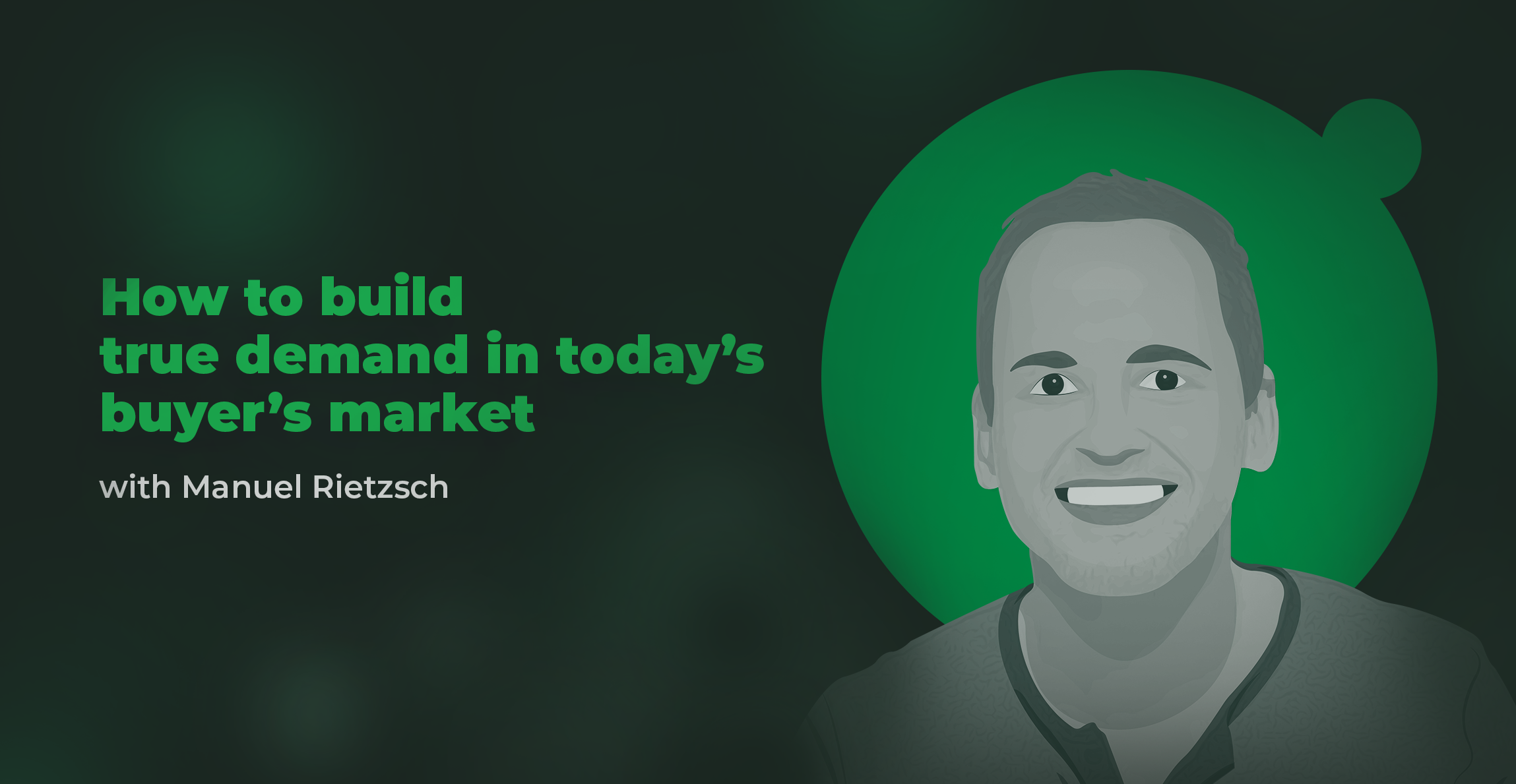The undeniable reality of demand marketing is that buying behaviors have changed, and the old tried-and-true playbook hasn’t aged gracefully.
“It’s much more a buyer’s market now than it used to be,” says Manuel Rietzsch, VP of Revenue Marketing at AudioEye. “There was much less information out there, and buyers had to engage with vendors much sooner in the cycle to get that information.”
Manuel has witnessed these transitions firsthand for the past two decades in B2B demand marketing. He’s led teams at Pluralsight, Hopin, InsideSales and Divvy, and serves as an advisor to several other organizations. He has collected particular insights into how the marketing playbook has become outdated—and how to build true demand in today’s market.
In this interview, Manuel looks at what makes today’s market so buyer-centric, why marketing teams need to get comfortable with the long game, what attribution-heavy strategies miss about organic marketing methods, and how marketing organizations can optimize themselves by focusing on the right programs (even when managing budget constraints).
It’s a buyer’s world: Meet them where they are
Manuel says that it’s a buyer’s market out there because the dynamics have shifted to where buyers have abundant options—and marketers must jockey for limited attention and resources. In this environment, buying behaviors have changed well beyond just the tools that marketers use to communicate with potential buyers.
It’s a lot like the ways that film production must shift over time in order to keep pace with evolving viewership. Marketers have to adapt their playbook to how, exactly, today’s market favors buyers and presents increasing challenges for demand marketing teams.
- So much info, so much noise. Every strategy you’re using to reach buyers, your competitors are using too. Then multiply that for every product and service vying for your audience’s attention—we’re all awash in marketing. “So many companies market and target the same people that everybody else wants to sell to,” Manuel says.
- People know the process. The first marketing email you ever got, if you can remember it, might have surprised you. How could you know that giving out your email address would result in a sales attempt? Now, it’s beyond given. “People know the process,” Manuel says. “They know that if they fill out a form and they download something, they will get a call from the SDR and they’re getting a lot of emails sent to them. People don’t want that anymore.”
- Trust is shifting from brands to peers. “There’s a loss of trust in companies and marketing in general,” Manuel says, “and buyers are much more shifting to trusting their peers.” He also notes that customers tend to engage with peers (whether colleagues, personal acquaintances, online reviews or social media connections) long before they actually engage with a vendor. “People follow people,” he says. “We pay much more attention to what people have to say than we do what brands have to say.”
- People prefer the B2C engagement style over the classic B2B one. “People want to go somewhere and educate themselves on their own time, their own pace and want venders to give them all the information they need to make a decision,” Manuel says. They don’t want to be nudged or nurtured or led to water by an SDR, but they do want to understand what you offer, how you solve their challenges and how you provide solutions that they need.
- We consume content differently now. Successful marketing playbooks used to feature high-value downloadables like white papers and ebooks. Those still have their place—but now, “We are so much more used to scrolling through bite-sized content,” Manuel says.
Any one of these dynamics shifting might require a marketing team to rethink its strategy. All of them? “You’ve got to approach people differently and meet them where they are,” Manuel says. “You can’t just rely on the old fill-out-my-form kind of motion.”
Demand isn’t instantaneous: Play the long game
We’ve heard a frightening (maybe even controversial) statement recently that demand is dead—that you can’t generate demand anymore.
Manuel weighs in that this statement is true. Half true, anyway. Because there is creating demand for your solution—and then there is forcing demand. The latter looks like cold calling, for example, and generally sees very, very low conversion rates.
If that approach isn’t dead in B2B, it’s dying.
“How do you market to somebody and create demand with somebody who either doesn’t have a challenge right now, doesn’t have initiative, doesn’t have budget, or isn’t making the buying decision on their own?” he asks. “It’s really hard to do that.”
Manuel sees that some small percentage of the market is both in your ICP and actively looking for solutions. It’s the other, much larger group where he identifies the potential for creating real demand.
“That’s where you can create demand long-term by educating them, by creating that relationship with them, by showing them that you understand their challenges and that you are able to solve their challenges—and you have solved their challenges for lots of other customers successfully,” he says.
Keep hitting the pavement: Optimize the short game
To generate long-term demand, though, marketing teams need to make the long-term play of creating relationships with potential buyers. This is exponentially more difficult when there are multiple people involved in the buying decision, each one held accountable. It’s much harder to create short-term demand if there are no initiatives and challenges that prospects have top-of-mind.
Harder, but not impossible—if we optimize our short-term demand engine. Yes, even with cold-calling.
“As marketers, we can equip and point our BDRs and SDRs in the right directions,” Manuel says. “What accounts are hitting our website, who’s showing intent. That’s where there might be some short-term demand. We just don’t know who they are yet because they haven’t filled out a form. But we can point to the accounts hitting our website. Let’s go after them. Let’s identify the personas within that account, start being proactive.”
Attribution is not a stand-alone: Lean into organic channels, too
Above, Manuel listed that buyers consume content differently now, especially with seeking their own information. We wondered what unexpected channels he would identify as highly relevant and effective in today’s market.
His answer: The ones marketers tend to ignore.
“Marketers have always defaulted to the channels that are closer to us, because we can measure and track them much more easily,” he says. “Paid search, SEO. It’s much harder for me to measure and really understand what impact my podcast has, or a community that I sponsor has.”
These channels may not be more important, but they are underutilized. To use them more, Manuel suggests that marketers (and our counterparts in finance) need to grow more comfortable with investing in activities that our attribution systems don’t fully pick up.
“One thing that I’ve seen really work is creating good organic thought leadership on LinkedIn,” he says. “Actually make that an orchestrated demand initiative instead of it being an unmanaged thing.”
This play connects with the idea that people follow people and pay attention to what they have to say, more than they do with brands. In other words: remember the human element to really understand what connects with your buyers. “Demand has relied heavily on paid tactics in the past,” Manuel says. “I think it can shift to more of this organic and community marketing.”
Remember that attribution and organic play together
Attribution better not go out the window altogether—through various platforms, marketing teams can boost engagement and visibility of these organic programs. The danger in leaning too heavily on attribution is that it can pick up an exact moment of interaction with a prospect, while overlooking all the levels of organic engagement that preceded it.
During a relevant project he worked on, Manuel compared an attribution tool with self-reported attribution and found nearly completely incompatible results. Self-reported attribution showed entry points that never would have showed up in the attribution tool itself.
Marketing teams need this deeper, more holistic understanding to point sales teams in the right directions. (In fact, Manuel points to this alignment as the reason for the advent of RevOps teams.)
“Before somebody engages with you, they read a post on LinkedIn and they asked a peer about you,” he proposes. “They might’ve seen somebody talking about you on Twitter, they’ve listened to podcasts, and then they go to Google. The only thing you’re going to see is the attribution to Google search—and this can create bad behavior if you put more money and focus on Google and no effort put into these other things that actually are creating the demand.”
Final thought: Lean, mean demand machines
Regardless of what’s happening in the buyer’s market, most marketing teams are facing a different, internal constraint: consolidation. Do more with less—we’ve all heard it. So how do we deal with these frictions?
Manuel offers a paradigm shift. It’s not do more with less. Instead, it’s do more of the right things.
“When I do consulting or I come into a new company, what I see is quite a bit of waste,” he says. “I always look at it as the 80/20 rule: 20% of your activities lead to 80% of your pipeline.”
When the economy is great, Marketing gets to ride the wave of higher budgets, more headcount, so very many tools. Now, with times more uncertain, we all get forced to do our work more efficiently and with a different focus.
“I think we need to focus much more on revenue and business outcomes—not leads, not MQL, but pipeline and revenues,” Manuel says. “This requires a change in mindset. We have to feel comfortable with shutting off the channels that the data tells us aren’t working.”
In the end, Manuel says, marketing teams can run really efficiently—and the C-suite knows it. Marketers are going to be held more and more accountable, which means that the same old playbook isn’t going to keep cutting it. The market has changed, buyers have changed—and Marketing gets to lean into what matters most to their buyers.


